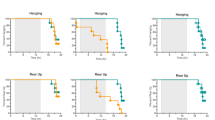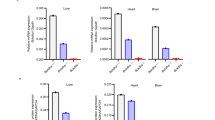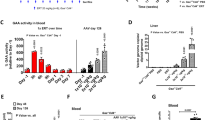Abstract
Hyperammonemia, a condition present in patients with urea cycle disorders (UCDs) or liver diseases, can cause neuropsychiatric complications, which in the worst cases result in brain damage, coma or death. Diverse treatments exist for the treatment of hyperammonemia, but they have limited efficacy, adverse effects and elevated cost. Gene therapy is a promising alternative that is explored here. A baculovirus, termed Bac-GS, containing the glutamine synthetase (GS) gene was constructed for the in vitro and in vivo treatment of hyperammonemia. Transduction of MA104 epithelial or L6 myoblast/myotubes cells with Bac-GS resulted in a high expression of the GS gene, an increase in GS concentration, and a reduction of almost half of exogenously added ammonia. When Bac-GS was tested in an acute hyperammonemia rat model by intramuscularly injecting the rear legs, the concentration of ammonia in blood decreased 351 μM, in comparison with controls. A high GS concentration was detected in gastrocnemius muscles from the rats transduced with Bac-GS. These results show that gene delivery for overexpressing GS in muscle tissue is a promising alternative for the treatment of hyperammonemia in patients with acute or chronic liver diseases and hepatic encephalopathy or UCD.
This is a preview of subscription content, access via your institution
Access options
Subscribe to this journal
Receive 12 print issues and online access
$259.00 per year
only $21.58 per issue
Buy this article
- Purchase on Springer Link
- Instant access to full article PDF
Prices may be subject to local taxes which are calculated during checkout





Similar content being viewed by others
References
Ferenci P, Lockwood A, Mullen K, Tarter R, Weissenborn K, Blei AT . Hepatic encephalopathy—definition, nomenclature, diagnosis, and quantification: final report of the working party at the 11th World Congresses of Gastroenterology, Vienna, 1998. Hepatology 2002; 35: 716–721.
Walker V . Ammonia toxicity and its prevention in inherited defects of the urea cycle. Diabetes Obes Metab 2009; 11: 823–835.
Felipo V . Hepatic encephalopathy: effects of liver failure on brain function. Nat Rev Neurosci 2013; 14: 851–858.
Clemmesen JO, Larsen FS, Kondrup J, Hansen BA, Ott P . Cerebral herniation in patients with acute liver failure is correlated with arterial ammonia concentration. Hepatology 1999; 29: 648–653.
Ong JP, Aggarwal A, Krieger D, Easley KA, Karafa MT, Van Lente F et al. Correlation between ammonia levels and the severity of hepatic encephalopathy. Am J Med 2003; 114: 188–193.
Jover R, Rodrigo R, Felipo V, Insausti R, Sáez-Valero J, García-Ayllón MS et al. Brain edema and inflammatory activation in bile duct ligated rats with diet-induced hyperammonemia: a model of hepatic encephalopathy in cirrhosis. Hepatology 2006; 43: 1257–1266.
Bernal W, Hall C, Karvellas CJ, Auzinger G, Sizer E, Wendon J . Arterial ammonia and clinical risk factors for encephalopathy and intracranial hypertension in acute liver failure. Hepatology 2007; 46: 1844–1852.
Seyan AS, Hughes RD, Shawcross DL . Changing face of hepatic encephalopathy: role of inflammation and oxidative stress. World J Gastroenterol 2010; 16: 3347–3357.
Felipo V, Urios A, Montesinos E, Molina I, Garcia-Torres ML, Civera M et al. Contribution of hyperammonemia and inflammatory factors to cognitive impairment in minimal hepatic encephalopathy. Metab Brain Dis 2012; 27: 51–58.
Llansola M, Montoliu C, Cauli O, Hernández-Rabaza V, Agustí A, Cabrera-Pastor A et al. Chronic hyperammonemia, glutamatergic neurotransmission and neurological alterations. Metab Brain Dis 2013; 28: 151–154.
Rama Rao KV, Jayakumar AR, Tong X, Alvarez VM, Norenberg MD . Marked potentiation of cell swelling by cytokines in ammonia-sensitized cultured astrocytes. J Neuroinflammation 2010; 7: 66.
Rodrigo R, Cauli O, Gomez-Pinedo U, Agusti A, Hernandez-Rabaza V, Garcia-Verdugo JM et al. Hyperammonemia induces neuroinflammation that contributes to cognitive impairment in rats with hepatic encephalopathy. Gastroenterology 2010; 139: 675–684.
Häussinger D, Sies H . Hepatic encephalopathy: clinical aspects and pathogenetic concept. Arch Biochem Biophys 2013; 536: 97–100.
Lachmann V, Görg B, Bidmon HJ, Keitel V, Häussinger D . Precipitants of hepatic encephalopathy induce rapid astrocyte swelling in an oxidative stress dependent manner. Arch Biochem Biophys 2013; 536: 143–151.
Mas A, Rodés J, Sunyer L, Rodrigo L, Planas R, Vargas V et al. Comparison of rifaximin and lactitol in the treatment of acute hepatic encephalopathy: results of a randomized, double-blind, double-dummy, controlled clinical trial. J Hepatol 2003; 38: 51–58.
Sharma P, Sharma BC, Puri V, Sarin SK . An open-label randomized controlled trial of lactulose and probiotics in the treatment of minimal hepatic encephalopathy. Eur J Gastroenterol Hepatol 2008; 20: 506–511.
Sharma BC, Sharma P, Agrawal A, Sarin SK . Secondary prophylaxis of hepatic encephalopathy: an open-label randomized controlled trial of lactulose versus placebo. Gastroenterology 2009; 137: 885–891.
Bass NM, Mullen KD, Sanyal A, Poordad F, Neff G, Leevy CB et al. Rifaximin treatment in hepatic encephalopathy. N Engl J Med 2010; 362: 1071–1081.
Agrawal A, Sharma BC, Sharma P, Sarin SK . Secondary prophylaxis of hepatic encephalopathy in cirrhosis: an open-label, randomized controlled trial of lactulose, probiotics, and no therapy. Am J Gastroenterol 2012; 107: 1043–1050.
Sharma P, Sharma BC, Agrawal A, Sarin SK . Primary prophylaxis of overt hepatic encephalopathy in patients with cirrhosis: an open labeled randomized controlled trial of lactulose versus no lactulose. J Gastroenterol Hepatol 2012; 27: 1329–1335.
Huang E, Esrailian E, Spiegel BM . The cost-effectiveness and budget impact of competing therapies in hepatic encephalopathy—a decision analysis. Aliment Pharmacol Ther 2007; 26: 1147–1161.
Phongsamran PV, Kim JW, Cupo Abbott J, Rosenblatt A . Pharmacotherapy for hepatic encephalopathy. Drugs 2010; 70: 1131–1148.
Alexander IE, Kok C, Dane AP, Cunningham SC . Gene therapy for metabolic disorders: an overview with a focus on urea cycle disorders. J Inherit Metab Dis 2012; 35: 641–645.
Krajewski WW, Collins R, Holmberg-Schiavone L, Jones TA, Karlberg T, Mowbray SL . Crystal structures of mammalian glutamine synthetases illustrate substrate-induced conformational changes and provide opportunities for drug and herbicide design. J Mol Biol 2008; 375: 217–228.
Morgan MY, Blei A, Grüngreiff K, Jalan R, Kircheis G, Marchesini G et al. The treatment of hepatic encephalopathy. Metab Brain Dis 2007; 22: 389–405.
Wright G, Noiret L, Olde Damink SW, Jalan R . Interorgan ammonia metabolism in liver failure: the basis of current and future therapies. Liver Int 2011; 31: 163–175.
Rose CF . Ammonia-lowering strategies for the treatment of hepatic encephalopathy. Clin Pharmacol Ther 2012; 92: 321–331.
Kost TA, Condreay JP, Jarvis DL . Baculovirus as versatile vectors for protein expression in insect and mammalian cells. Nat Biotechnol 2005; 23: 567–575.
Airenne KJ, Hu YC, Kost TA, Smith RH, Kotin RM, Ono C et al. Baculovirus: an insect-derived vector for diverse gene transfer applications. Mol Ther 2013; 21: 739–749.
Luo WY, Lin SY, Lo KW, Lu CH, Hung CL, Chen CY et al. Adaptive immune responses elicited by baculovirus and impacts on subsequent transgene expression in vivo. J Virol 2013; 87: 4965–4973.
Pieroni L, Maione D, La Monica N . In vivo gene transfer in mouse skeletal muscle mediated by baculovirus vectors. Hum Gene Ther 2001; 12: 871–881.
Lin CY, Lu CH, Luo WY, Chang YH, Sung LY, Chiu HY et al. Baculovirus as a gene delivery vector for cartilage and bone tissue engineering. Curr Gene Ther 2010; 10: 242–254.
Luo WY, Shih YS, Lo WH, Chen HR, Wang SC, Wang CH et al. Baculovirus vectors for antiangiogenesis-based cancer gene therapy. Cancer Gene Ther 2011; 18: 637–645.
Feng B, Shiber SK, Max SR . Glutamine regulates glutamine synthetase expression in skeletal muscle cells in culture. J Cell Physiol 1990; 145: 376–380.
Hilgier W, Olson JE . Brain ion and amino acid contents during edema development in hepatic encephalopathy. J Neurochem 1994; 62: 197–204.
Rangroo Thrane V, Thrane AS, Chang J, Alleluia V, Nagelhus EA, Nedergaard M . Real-time analysis of microglial activation and motility in hepatic and hyperammonemic encephalopathy. Neuroscience 2012; 220: 247–255.
Miyashita T, Enosawa S, Suzuki S, Tamura A, Tanaka H, Amemiya H et al. Development of a bioartificial liver with glutamine synthetase-transduced recombinant human hepatoblastoma cell line, HepG2. Transplant Proc 2000; 32: 2355–2358.
Tang NH, Wang XQ, Li XJ, Chen YL . Ammonia metabolism capacity of HepG2 cells with high expression of human glutamine synthetase. Hepatobiliary Pancreat Dis Int 2008; 7: 621–627.
Labow BI, Souba WW, Abcouwer SF . Mechanisms governing the expression of the enzymes of glutamine metabolism—glutaminase and glutamine synthetase. J Nutr 2001; 131: 2467S–2474S; discussion 2486S–7S.
Huang YF, Wang Y, Watford M . Glutamine directly downregulates glutamine synthetase protein levels in mouse C2C12 skeletal muscle myotubes. J Nutr 2007; 137: 1357–1362.
Wang Y, Watford M . Glutamine, insulin and glucocorticoids regulate glutamine synthetase expression in C2C12 myotubes, Hep G2 hepatoma cells and 3T3 L1 adipocytes. Biochim Biophys Acta 2007; 1770: 594–600.
He Y, Hakvoort TB, Köhler SE, Vermeulen JL, de Waart DR, de Theije C et al. Glutamine synthetase in muscle is required for glutamine production during fasting and extrahepatic ammonia detoxification. J Biol Chem 2010; 285: 9516–9524.
Ganda OP, Ruderman NB . Muscle nitrogen metabolism in chronic hepatic insufficiency. Metabolism 1976; 25: 427–435.
Girard G, Butterworth RF . Effect of portacaval anastomosis on glutamine synthetase activities in liver, brain, and skeletal muscle. Dig Dis Sci 1992; 37: 1121–1126.
Desjardins P, Rao KV, Michalak A, Rose C, Butterworth RF . Effect of portacaval anastomosis on glutamine synthetase protein and gene expression in brain, liver and skeletal muscle. Metab Brain Dis 1999; 14: 273–280.
Chatauret N, Desjardins P, Zwingmann C, Rose C, Rao KV, Butterworth RF . Direct molecular and spectroscopic evidence for increased ammonia removal capacity of skeletal muscle in acute liver failure. J Hepatol 2006; 44: 1083–1088.
van Straaten HW, He Y, van Duist MM, Labruyère WT, Vermeulen JL, van Dijk PJ et al. Cellular concentrations of glutamine synthetase in murine organs. Biochem Cell Biol 2006; 84: 215–231.
Rose C, Michalak A, Rao KV, Quack G, Kircheis G, Butterworth RF . L-ornithine-L-aspartate lowers plasma and cerebrospinal fluid ammonia and prevents brain edema in rats with acute liver failure. Hepatology 1999; 30: 636–640.
Bosoi CR, Parent-Robitaille C, Anderson K, Tremblay M, Rose CF . AST-120 (spherical carbon adsorbent) lowers ammonia levels and attenuates brain edema in bile duct-ligated rats. Hepatology 2011; 53: 1995–2002.
Oria M, Romero-Giménez J, Arranz JA, Riudor E, Raguer N, Córdoba J . Ornithine phenylacetate prevents disturbances of motor-evoked potentials induced by intestinal blood in rats with portacaval anastomosis. J Hepatol 2012; 56: 109–114.
Odena G, Miquel M, Serafín A, Galan A, Morillas R, Planas R et al. Rifaximin, but not growth factor 1, reduces brain edema in cirrhotic rats. World J Gastroenterol 2012; 18: 2084–2091.
Cunningham SC, Kok CY, Spinoulas A, Carpenter K H, Alexander IE . AAV-encoded OTC activity persisting to adulthood following delivery to newborn spf(ash) mice is insufficient to prevent shRNA-induced hyperammonaemia. Gene Therapy 2013; 20: 1184–1187.
Lee EK, Hu C, Bhargava R, Ponnusamy R, Park H, Novicoff S et al. AAV-based gene therapy prevents neuropathology and results in normal cognitive development in the hyperargininemic mouse. Gene Therapy 2013; 20: 785–796.
McGivan JD, Bungard CI . The transport of glutamine into mammalian cells. Front Biosci 2007; 12: 874–882.
Urabe M, Ding C, Kotin RM . Insect cells as a factory to produce adeno-associated virus type 2 vectors. Hum Gene Ther 2002; 13: 1935–1943.
Mena JA, Ramírez OT, Palomares LA . Titration of non-occluded baculovirus using a cell viability assay. Biotechniques 2003; 34: 260–264.
Keil GM, Klopfleisch C, Giesow K, Blohm U . Novel vectors for simultaneous high-level dual protein expression in vertebrate and insect cells by recombinant baculoviruses. J Virol Methods 2009; 160: 132–137.
Acknowledgements
We thank Lizbeth M Vázquez-Carcaño, Dafne Juárez-Galicia and Erika Chavira-Suárez (Instituto Nacional de Ciencias Médicas y Nutrición Salvador Zubirán) for excellent technical assistance. This work was supported by the Institute of Science and Technology from Mexico City (ICyT-DF grant PICDS08-75).
Author information
Authors and Affiliations
Corresponding author
Ethics declarations
Competing interests
The authors declare no conflict of interest.
Rights and permissions
About this article
Cite this article
Torres-Vega, M., Vargas-Jerónimo, R., Montiel-Martínez, A. et al. Delivery of glutamine synthetase gene by baculovirus vectors: a proof of concept for the treatment of acute hyperammonemia. Gene Ther 22, 58–64 (2015). https://doi.org/10.1038/gt.2014.89
Received:
Revised:
Accepted:
Published:
Issue Date:
DOI: https://doi.org/10.1038/gt.2014.89
This article is cited by
-
Solutions against emerging infectious and noninfectious human diseases through the application of baculovirus technologies
Applied Microbiology and Biotechnology (2021)



